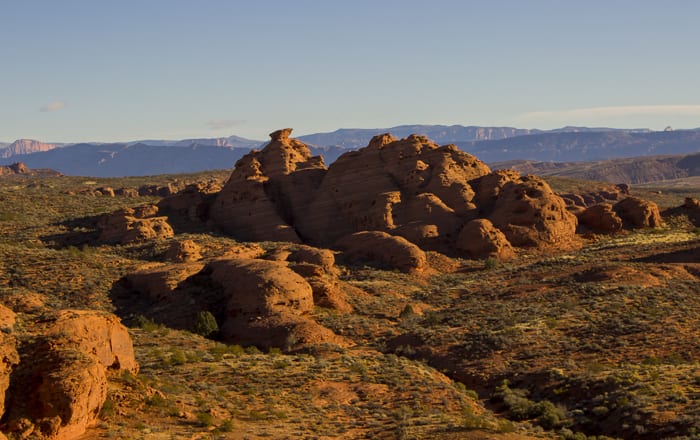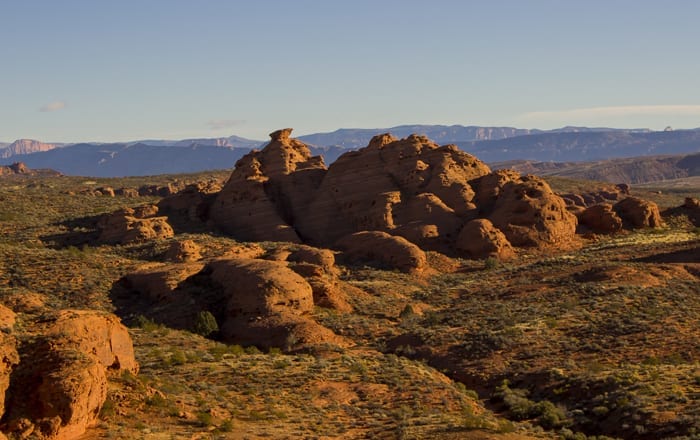 |
| Photo: Don Gilman |
Written by Don Gilman
Part I: An introduction
There is a ghost in the desert. It takes the sinuous form of a snake, winding around and across mesas and buttes, twisting for miles to connect Interstate-15 and Red Hills Parkway. This apparition right now stretches through undeveloped lands, just a ghost of an idea, but someday in the future it could become very real. This ghost highway has a name: the Northern Corridor, also known as the Washington Parkway.
There is a conflict involving the ghost highway, a Byzantine drama unfolding between several factions.
The BLM, as required by law, recently released the Draft Environmental Impact Statement (DEIS) for the Beaver Dam National Conservation Area and the Red Cliffs National Conservation Area. Included in the DEIS is an option—one out of many—that would allow the Northern Corridor to be built. The DEIS is currently open for public comment.
There are two armies on each side of the Northern Corridor, men and women with very different views about conservation and development, men and women with divergent views about the future of Washington County. This article is the first in a series that will examine the quiet war being waged over the future of this parkway.
There are only two National Conservation Areas in Utah. Both happen to be in Washington County: Beaver Dam National Conservation Area and the Red Cliffs National Conservation Area. Both are home to the third factor in this divisive issue: the Mojave Desert Tortoise.
The Desert Tortoise has been federally listed as ‘threatened’ since 1990, and the St. George area is prime real estate for these slow moving, vulnerable reptiles. This area is also the epicenter of a struggle between powerful figures deciding its future. With the accelerated growth of Washington County, the pressure on the tortoise is increasing, and the political pressure to see this project completed is also growing.
This war is being waged on many levels, from private citizens to professional politicians. Municipal, county, state and federal politics are all contributing to a complicated labyrinth of laws and opinions, each side having starkly opposite views of interpretation.
Washington County sees the parkway as a means to alleviate traffic as growth in the municipalities continues.
Their opponents—the lawyers, writers, activists and everyday lay people—believe that the construction of this parkway will create a new division in the NCA, and further isolate and strain tortoise populations.
Former Utah State Attorney General Paul Van Dam believes the political impetus to get the parkway constructed is a pet project that will further degrade tortoise habitat and will not alleviate traffic congestion. Given his legal experience as not only a former district attorney but also attorney general for the State of Utah, Van Dam is a key figure in this battle over the parkway.
“They believe it’s kind of the key to the future of this part of the valley,” Van Dam said. “In a way, it’s nonsensical, because it really doesn’t do that much for them. In another way it’s very powerful because they need to prevail.…. The way they are going to prevail is to get the Northern Corridor, and get [the proposed Lake Powell pipeline.] Those are the two fronts they’ve held fast to and really put a lot of time and effort and money into.”
Joining him in this struggle is his partner, Lisa Rutherford. Together they have been working to keep the tortoise habitat protected from rapid development, and this conflict over the Northern Corridor has been an issue they both say they find troubling. Rutherford said she believes Washington County would be better served with a road stretching much farther to the north, along Danish Ranch Road, the ‘Great Northern Corridor.’
“I think it’s something worth considering,” Rutherford said. “Why not do the Great Northern Corridor, keep it out of the Reserve, so there’s no [legal] challenges that have to be dealt with? Make it a toll road, so that anybody who wants to use it can pay for that use.”
Tom Butine, board president for Citizen’s for Dixie’s Future, has likewise followed the issue of the Northern Corridor.
“The BLM is bound by law to consult with the local authorities and their opinions in what do with the National Conservation Area. The County and City back [the Northern Corridor] too,” Butine said. “They’ve been wanting to put a road through the red cliffs NCA. The County has had it in their transportation plans, with several different options for the routing of that road. The BLM is required to consider their requests.”
Butine feels that there are more pressing needs in the County besides the parkway.
“When the County agreed in [the Washington County Resource Management Plan], part of that whole understanding was there wouldn’t be any roads in there. Unfortunately the County still wants to press roads in there. We think it would be a lot better to relieve that traffic congestion. Better than putting in a road that loops way up to the north. It’s a little disappointing the County is still pressing this.”
For the BLM’s part in this issue, one of the central figures in this dilemma is Dawna Ferris-Rowley, assistant field office manager for the St. George region. Ferris-Rowley is uneasy at the prospect of a road through the National Conservation Area.
“The language of this bill is problematic,” Ferris-Rowley said. “From the standpoint of looking for a corridor for something that doesn’t exist today. But where the nexus has been interpreted to us at least by the County and the State is for us to include something through the Red Cliffs National Conservation Area and make a land-use allocation of a corridor in which that road could go.”
Ferris-Rowley says that creating the Northern Corridor is inconsistent with the goals of the BLM.
“You get a very strong conservation focus when Congress designates public lands to be part of a conservation area,” she said. “They tell us ‘conserve, protect, enhance.’ That’s a standard of conservation. If this is to be taken seriously, I believe that our findings say that this alternative that would designate this corridor would not be consistent with congressional purpose for which the public lands were designated.”
Ferris-Rowley agrees with the assessment that the County has relentlessly pursued construction of the Northern Corridor, despite the creation of the Red Cliffs National Conservation Area.
“The road has never really died as far as local elected officials,” Ferris-Rowley said. ”Every time it would surface, Fish and Wildlife would send a letter to either the mayor or county commissioners and say ‘That road, we said ‘no’ when it was first proposed while you were developing your [Habitat Conservation Plan] and we’re still saying ‘no.’’ So year after year, you have a chronology of letters which are, of course, a matter of public record.”
Van Dam also believes that Fish and Wildlife is the lynchpin of the entire affair.
“The only thing really stopping them on this road is Fish and Wildlife. Fish and wildlife has primary jurisdiction. Under environmental laws, they have to okay it. That’s why in that piece of legislation, it says with particularity that fish and wildlife cannot stop the process,” Van Dam said.
The piece of legislation to which Van Dam is referring is S. 1783, an amendment to the Omnibus Act of 2009 that officially created the Red Cliffs National Conservation Area.
The amendment states: “Section 1977(b)(2) of the Omnibus Public Land Management Act of 2009…is amended by striking subparagraph (A) and inserting the following: “(A) ensure the travel management plan — “(i) designates a northern transportation route in the county that follows the route depicted on the map entitled ‘Washington Parkway’; and “(ii) provides the designation and construction of the route is not subject to additional restrictions or requirements from the United States Fish and Wildlife Service.”
According to Rutherford and Van Dam, the status of this proposed bill is unknown.
This issue runs deep. There are a myriad of influences at work on the outcome of not only the BLM’s Environmental Impact Statement but on the amendment to the 2009 Omnibus as well. From the grassroots level all the way up to the halls of Congress, there are forces at work that will have a direct and powerful impact on Washington County for years to come.
The Northern Corridor may or may not ever be constructed; it is still too far removed to tell. There are too many steps, too many legalities and hoops to jump through. However, the fight is just beginning.
Check back next week for the second part in this series: The builders
Subscribe for FREE to get our weekly Sunday Edition email, just signup in the NEWSLETTER box on the right –>





Why isn’t there a simple map in these articles to show the planned routes?